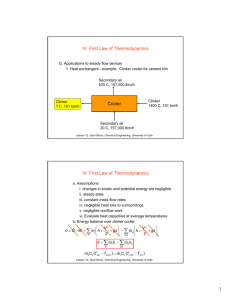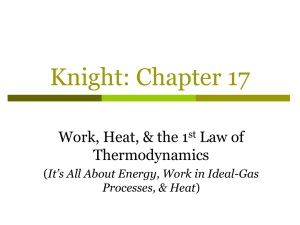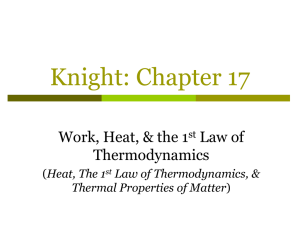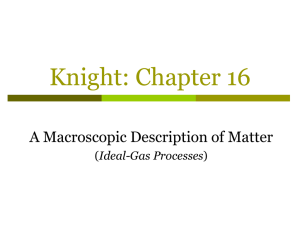Lecture 9 - Department of Chemical Engineering
advertisement
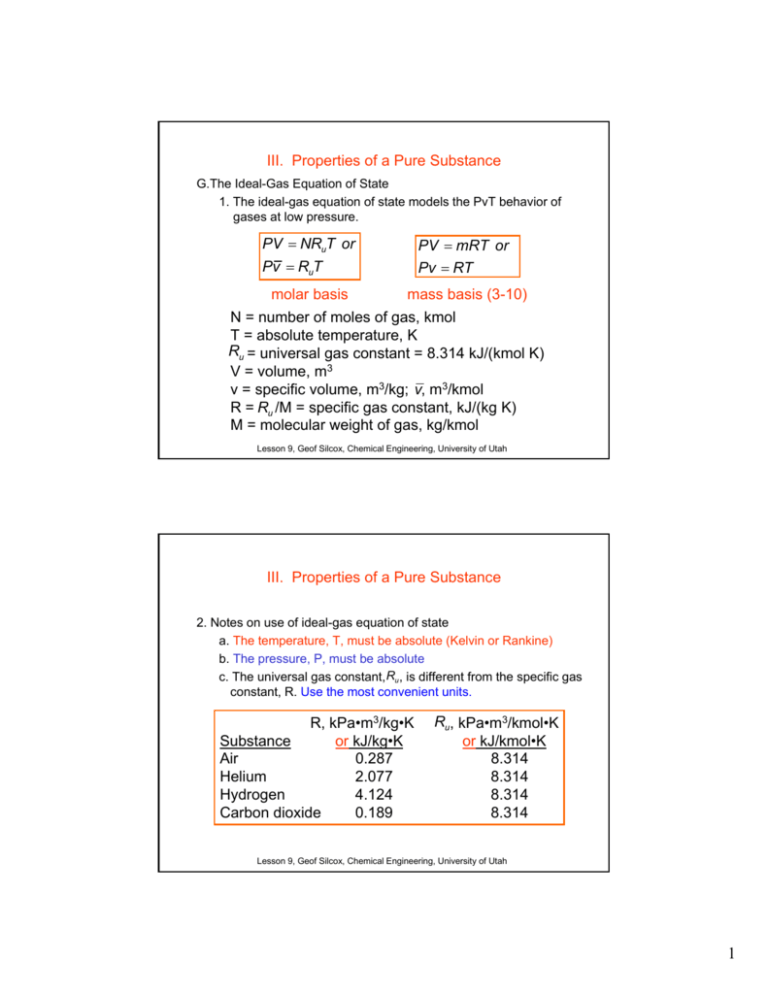
III. Properties of a Pure Substance G.The Ideal-Gas Equation of State 1. The ideal-gas equation of state models the PvT behavior of gases at low pressure. PV = NRuT or PV = mRT or Pv = RuT Pv = RT molar basis mass basis (3-10) N = number of moles of gas, kmol T = absolute temperature, K Ru = universal gas constant = 8.314 kJ/(kmol K) V = volume, m3 v = specific volume, m3/kg; v, m3/kmol R = Ru /M = specific gas constant, kJ/(kg K) M = molecular weight of gas, kg/kmol Lesson 9, Geof Silcox, Chemical Engineering, University of Utah III. Properties of a Pure Substance 2. Notes on use of ideal-gas equation of state a. The temperature, T, must be absolute (Kelvin or Rankine) b. The pressure, P, must be absolute c. The universal gas constant, Ru , is different from the specific gas constant, R. Use the most convenient units. R, kPa•m3/kg•K Substance or kJ/kg•K Air 0.287 Helium 2.077 Hydrogen 4.124 Carbon dioxide 0.189 Ru, kPa•m3/kmol•K or kJ/kmol•K 8.314 8.314 8.314 8.314 Lesson 9, Geof Silcox, Chemical Engineering, University of Utah 1 III. Properties of a Pure Substance 3.0 Example - Does superheated r-134a obey the ideal-gas law at P = 1.0 MPa and T = 100°C? Compare the specific volume calculated from the ideal-gas law with the property data in Table A-13. From Table A-13, vactual = 0.02755 m3/kg From Table A-1, M = 102.03 and R = 0.08149 kPa•m3/kg•K From the ideal-gas law 0.08149 kPa • m 3 (100 + 273.15 )K m3 kg • K = 0.03041 1000 kPa kg RT = P v − v actual %error = ideal x100% = 10.4% v actual v ideal = Lesson 9, Geof Silcox, Chemical Engineering, University of Utah III. Properties of a Pure Substance H. The Compressibility Factor and the Principle of Corresponding States 1. Compressibility factor Z= v actual Pv actual = v ideal RT (3-17, 18, 19) From the proceeding example, Z= v actual 0.02755 = = 0.906 v ideal 0.03041 Lesson 9, Geof Silcox, Chemical Engineering, University of Utah 2 III. Properties of a Pure Substance 2. Principle of Corresponding States a. Definition - the compressibility factor, Z, is about the same for most gases when they have the same reduced temperature and pressure. PR = P T and TR = Pcr Tcr (3-20) where absolute temperature and pressure are used. Lesson 9, Geof Silcox, Chemical Engineering, University of Utah III. Properties of a Pure Substance Fig. 3-51: Comparison of Z factors for several gases. Lesson 9, Geof Silcox, Chemical Engineering, University of Utah 3 III. Properties of a Pure Substance b. Example - for the conditions of the previous example for r-134a, use Fig. A-15 to calculate Z Z = f ( PR ,TR ) PR = P 1.0 MPa = = 0.2459 Pcr 4.067 MPa TR = T 373.15 K = = 0.9969 Tcr 374.3 K Z = 0.913 Lesson 9, Geof Silcox, Chemical Engineering, University of Utah III. Properties of a Pure Substance 3. How do we know if the ideal-gas law applies? a. PR << 1 at all temperatures (see Fig. A-15) b. TR > 2 except where PR >> 1 (see Fig. A-15) 4. When to use the ideal-gas law? The text has ideal-gas property tables for air, N2, O2, CO2, water vapor, and CO (Tables A-17 to A-25). The use of the air table (A-17) is not fully explained until Chapter 7. Note that Pr ≠ PR and vr ≠ vR. Use the ideal-gas law to calculate the density or specific volume of air and all other gases for which the ideal-gas law applies. As a general rule, do not use the ideal-gas law or the idealgas tables to calculate the properties of water or refrigerants in any state - use the tables. Lesson 9, Geof Silcox, Chemical Engineering, University of Utah 4 III. Properties of a Pure Substance 5. Example from first examination, Fall Semester 2000 Find the mass (kg) and weight (N) of the air contained in a 4.00-m-by-7.00-m-by-8.00-m room if the temperature and pressure of the air are 22.0 C and 0.825 atm. Assumption: the ideal-gas law applies Data: R = 0.2870 (kPa m3)/(kg K) (Table A-1) g = 9.81 m/s2 (inside front pages of book) T = 22 + 273.15 = 295.15 K Calculations: PV = mRT 101.325 kPa 0.825 atm ( 4 )7(8 )m 3 PV kg 1 atm m= = ρV = = 0.9868 3 224 m3 = 221 kg kPa • m 3 RT m 0.2870 ( 295.15 K ) kg • K weight = mg = 221 ( kg ) 9.81 m = 2170 N s2 Lesson 9, Geof Silcox, Chemical Engineering, University of Utah 5

